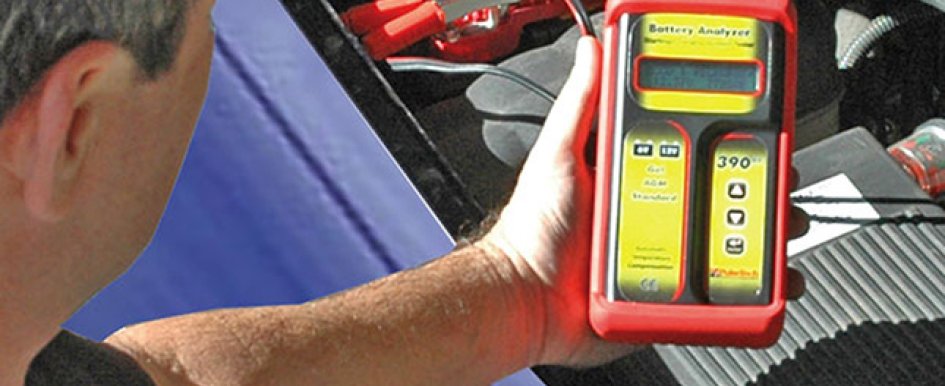
Dated battery maintenance schedules suggest that a lead-acid battery that is at the end of its service life—between two and three years—can’t be recharged enough to restore it to a useful power level and that it must be replaced.
However, a poorly maintained battery that has been attacked by microscopic sulfate crystals inhibiting the battery’s ability to create, store and release energy is typically worth saving. “Restored” batteries can provide years of extended service—in some cases, up to five times their original projected life cycle.
A lead-acid battery will continue to store and supply energy if enough of the active plate material is available to allow an energy transfer to occur naturally. In theory, lead-acid batteries should last many years, but they usually don’t because of problems caused by excessive sulfation buildup related to the natural and necessary formation of sulfate crystals on the surface of lead battery plates.
 390PT Battery Tester
390PT Battery TesterAs a battery ages through use or sits unused, these lead sulfate crystals enlarge and can build up until they create a physical barrier across the surface of the plate. Before long, this buildup can become so dense that a battery can no longer accept or release energy.
For commercial equipment and fleet maintenance managers, proper battery maintenance is both a field performance issue as well as a budget line item consideration. The maintenance formula—test, charge, recover and maintain—is proven methodology to keep today’s fleet batteries in peak condition.
In one recent case study, a client spent $9,000 on the purchase of multi-station conditioning chargers, maintainers and battery testers to run diagnostics and maintenance on 616 batteries that were considered unusable. Using a battery manager maintenance program, the client recovered and kept in service 359 of those batteries, representing a cost savings of more than $40,000.
Battery Testing
Testing gives a detailed snapshot of a battery’s condition and allows users to identify failing batteries before they become a problem. When testing a lead-acid battery, know the battery’s voltage, cold cranking amps (CCA), state of health and state of charge. State of health shows how much battery capacity (in percentages) is left compared to the marked original battery capacity. State of charge is a measurement of voltage and shows what percent of the battery is actually charged. CCA shows the current in amperes that a battery can deliver for 30 seconds continuously without the terminal voltage falling below 1.2 volts per cell after it has been cooled to 0 degrees Fahrenheit and held at that temperature. This rating reflects the ability of the battery to deliver engine starting currents in winter conditions.
Battery “Vitamins”
If the battery does not recharge, you might have an alternator problem or electrical system issue, or the battery is suffering from sulfation buildup.
A test by your mechanic may identify the problem, or you might consider application of a recovery charger to evaluate the level of charge and automatically feed it “vitamins” through a powerful 16-amp, 12V charge that will also restore the function of the battery’s plates. Find charging systems that combine scientifically validated desulfation technologies.
This restorative technology utilizes a strictly controlled waveform, comprised of rise time, pulse-width frequency and amplitude of current and voltage pulse. Used as part of a routine maintenance program, such smart charges have improved battery performance and extended life cycles.
Lead-Acid Battery Discharge
All batteries, regardless of their chemistry, will self-discharge. The rate of self-discharge for lead-acid batteries depends on the storage or operating temperature. At a temperature of 80 degrees Fahrenheit, a lead-acid battery will self-discharge at a rate of approximately 4 percent per week. A battery with a 125-amp-hour rating will self-discharge at a rate of approximately five amps per week. Keeping this in mind, if a 125-AH battery is stored for four months (16 weeks) throughout the winter without being charged, it will lose 80 amps of its 125-amp capacity. It will also suffer from severe sulfation, inhibiting the plates from accepting and distributing a charge. Consider the following maintenance solution for stockpiled new batteries.
When new batteries arrive, place them on a fully automatic 12-station charger designed for any facility or shop that services multiple batteries and vehicles to keep stored lead-acid batteries factory fresh. Keep the twelve batteries charged and desulfated at all times. When one is used, immediately replace it with another.
Test the batteries to ensure they are holding a charge within 0.2 volts of each other. Using electronic battery testers, you can complete these tests in less than a minute. Technicians should employ a SC-12 HD charger to recover, maintain and return the batteries to a like-new state without having to remove the batteries from the vehicle. Once the batteries are charged, check them again, this time for full serviceability with the advanced battery analyzer. If a battery does not test to standard, replace it. That battery should begin the process again.
Battery Recovery
Recovering a discharged battery that will no longer accept a charge is possible, so use a battery analyzer to determine if the battery is a good candidate for recovery. (Note: Even though the analyzer may read “replace battery,” the battery could still be recoverable.) Smart charges that will analyze, charge and recover all types of lead-acid batteries are available on the market. Keep in mind that some badly sulfated battery plates could take several days to clean. Also, not all batteries can be totally recovered. If a battery has a short circuit or physical damage, recovery will be impossible.
